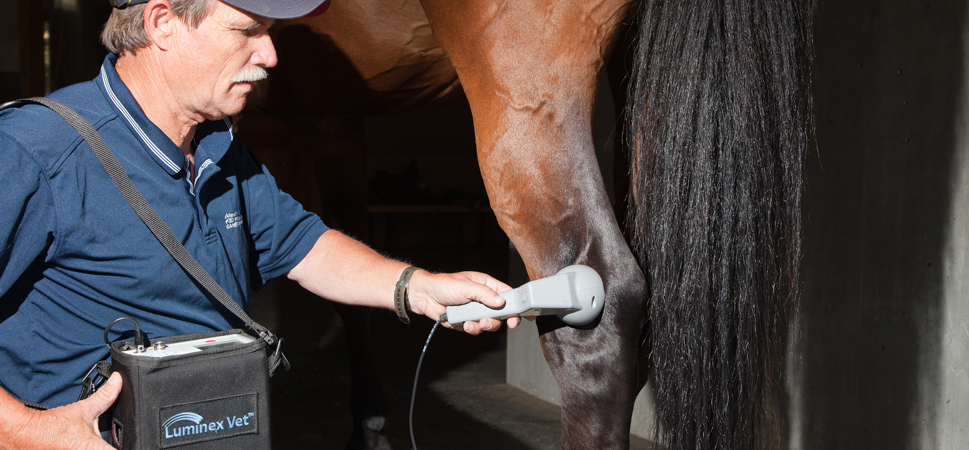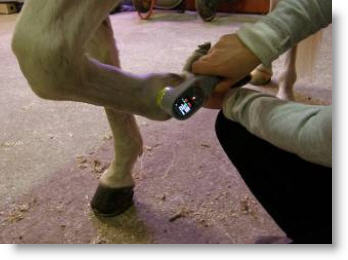How Laser Therapy in Horse Treatment Is Changing Veterinary Take Care Of Equines
Laser therapy has actually emerged as a transformative technique in equine veterinary treatment, giving a non-invasive option that expedites recovery and improves overall wellness. Leveraging accurate light wavelengths, this sophisticated therapy promotes cellular regeneration, lowers swelling, and alleviates pain. Its efficacy expands from musculoskeletal injuries to chronic disorders like osteo arthritis, substantially improving wheelchair and life top quality for horses. The transportability and flexibility of laser treatment tools better underscore their growing indispensability among veterinarians. As we check out the detailed technicians and real-world successes, the profound effect on equine medical practices ends up being progressively obvious.

Recognizing Laser Treatment
Comprehending laser therapy is essential for valuing its role in equine treatment. Laser therapy, additionally known as photobiomodulation, includes the application of certain wavelengths of light to cells, which can cause different biological effects. This healing technique utilizes the power of light power to permeate the skin and underlying tissues, boosting mobile processes and boosting cells repair service.
The technology behind laser treatment is based in the principle of photochemistry, where photons are absorbed by chromophores within cells, leading to increased ATP manufacturing and inflection of responsive oxygen varieties. This, subsequently, advertises cellular spreading, lowers inflammation, and accelerates recovery. Veterinary specialists utilize various sorts of lasers, including low-level lasers (LLLT) and high-power Class IV lasers, relying on the details healing goals and the nature of the equine condition being dealt with.
Different laser wavelengths and power setups are meticulously chosen to target various cells depths and achieve wanted medical end results. Safety and security procedures are vital, as improper use can cause thermal damage or suboptimal healing results. Hence, a detailed understanding of laser treatment's mechanisms and applications is crucial for its reliable execution in equine vet technique.
Advantages for Equine Health And Wellness
The myriad benefits of laser treatment for equine wellness encompass boosted healing, discomfort decrease, and boosted movement. This innovative therapy modality leverages particular wavelengths of light to permeate cells, boosting mobile function and promoting fast cells repair. The non-invasive nature of laser therapy guarantees very little stress and discomfort for the equine, helping with a smoother recuperation process.

Better movement is one more essential advantage, specifically for efficiency and working horses. By decreasing inflammation and discomfort, and improving tissue repair, laser therapy assists in bring back joint function and muscle adaptability. The collective effect of these benefits is not just a quicker go back to typical activity yet additionally a total improvement in the equine's lifestyle. Therefore, laser therapy stands as a transformative device in modern horse veterinary treatment.
Typical Problems Treated
Laser therapy has emerged as a flexible treatment alternative for a range of common equine problems. Additionally, laser therapy is reliable for problems like osteoarthritis, where it aids minimize joint inflammation and advertise tissue repair work.
Wound administration is one more location where laser therapy has actually revealed considerable guarantee. Chronic injuries or slow-healing abscess can be especially challenging in equines, however laser treatment improves mobile regeneration and boosts blood circulation, therefore quickening the healing process. Moreover, laser treatments have actually been efficiently utilized in taking care of unguis problems such as laminitis and abscesses, alleviating discomfort and advertising quicker recovery.
Equine professional athletes typically struggle with performance-related concerns like muscle soreness and anxiety fractures. Laser therapy help in reducing muscle mass fatigue and expedites the recuperation of micro-injuries, hence guaranteeing that equines return to come to a head performance faster. By dealing with these varied conditions, laser therapy is transforming the landscape of veterinary care, giving a non-invasive, reliable choice to traditional treatments.
Innovation Behind Laser Treatment

Laser tools used in veterinary medication frequently make use of low-level laser treatment (LLLT) or cool laser treatment. Unlike high-powered medical lasers, these devices run at lower power levels, optimizing therapeutic benefits while decreasing thermal damage. The power from the laser light promotes adenosine triphosphate (ATP) manufacturing, boosts cellular metabolism, and speeds up tissue fixing processes.
Modern laser treatment devices for equine treatment is designed with adjustable settings to accommodate the details requirements of various tissues and conditions. Equine check this Therapy. Parameters such as wavelength, power thickness, and treatment period can be finely tuned, offering customized therapeutic solutions. Furthermore, improvements in laser modern technology have actually brought about the growth of mobile, handheld devices, making it easier for veterinarians to provide therapy in a selection of setups, from clinics to stables. This technological advancement is a cornerstone in the reinventing of equine vet treatment.
Success Stories and Instance Studies
Showcasing the concrete benefits of laser treatment, many success tales and situation research studies illuminate its transformative influence on equine my blog wellness. One such instance includes a pedigreed racehorse struggling with persistent tendonitis. Typical therapies produced minimal renovation, but after integrating laser treatment into the regimen, the steed showed considerable reductions in swelling and discomfort within weeks, inevitably going back to competitive auto racing.
One more compelling example includes a dressage equine diagnosed with serious pain in the back, restricting its efficiency. A vet team utilized low-level laser treatment (LLLT) to target the inflamed locations, causing marked enhancement in flexibility and a significant decline in discomfort. Over several sessions, the steed reclaimed its peak type, showcasing the efficacy of laser therapy in dealing with musculoskeletal problems.
Furthermore, a research study carried out at a leading equine clinic taken a look at 50 horses with different soft tissue injuries treated with laser therapy. The results were striking: 85% of the steeds showed sped up healing times and boosted wheelchair. These cases highlight the convenience and performance of laser treatment in equine medication, supplying a non-invasive, scientifically-backed technique to improving recovery and efficiency in equines.
Verdict
Laser treatment is transforming equine vet care by supplying a non-invasive treatment that speeds up recovery, minimizes inflammation, and eases pain. With its effectiveness in treating an array of problems, from musculoskeletal injuries to click here for info chronic ailments like osteo arthritis, this technology considerably enhances equine health and wellness and wheelchair. The mobility and flexibility of laser therapy additionally emphasize its transformative influence on vet techniques, strengthening its function as an important device in modern-day equine healthcare.